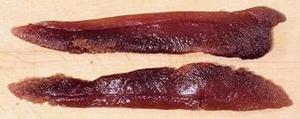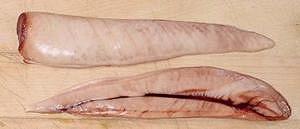Pacific Herring
 [Cá Trích (Viet); Clupea pallasii]
[Cá Trích (Viet); Clupea pallasii]
This herring, is found from the Mexican border of Southern California all
around the North Pacific to surround Japan and Korea, also in the Arctic
Ocean above Alaska and Western Canada. There are also populations along the
Arctic coast of Russia. A round bodied fish, it can grow to 18 inches but
is more commonly around 10 inches. The photo specimen was 14-1/2 inches and
weighed 14.6 ounces including milt sacs. This fish is very similar to the
Atlantic Herring. The photo example
was factory scaled in Vietnam, but otherwise intact. IUCN Red List DD
(Data Deficient) but is not thought to be threatened.
 Herring Roe. These Egg Sacks are from a 10 inch female and weighed 2.1 ounces,
6-1/2 inches long x 1-1/4 inches wide.
Herring Roe. These Egg Sacks are from a 10 inch female and weighed 2.1 ounces,
6-1/2 inches long x 1-1/4 inches wide.
Salted Herring Eggs (kazunoko) are traditional in Japan for the
New Year's feast, signifying lots of children and a prosperous family.
This use is declining as the feast becomes westernized, and "lots of children"
isn't as advantageous as in past times. Kelp coated with Herring Eggs is also
popular. In all the photos I've seen the eggs are light yellow or white.
These are darker, even when removed from the sacks, but very tiny, so
probably immature.
 These Milt Sacks are from the 14-1/2 inch male Herring pictured above. The
male needs a lot of milt because he just sprays it into the water near where
the eggs have been deposited. Edible, but only used in a few recipes.
These Milt Sacks are from the 14-1/2 inch male Herring pictured above. The
male needs a lot of milt because he just sprays it into the water near where
the eggs have been deposited. Edible, but only used in a few recipes.
More on the Herring Family.
See also Herring - Pickled, Canned,
Kippered and Dried
Herring is a "problem fish" because the flesh is so shot full of thread
bones. Fortunately most of these are so short and thin they need not be
removed. For Pickled Herring, the acid softens them so they aren't
noticeable. For smoked herring only the backbone and large rib bones
need to be removed.
Buying:
I have found these fish frozen whole in one of the
large Asian markets. They are not found pickled pickled in jars, nor packed
packed whole in salt brine like
Atlantic Herring, but they can be used in recipes calling for
"fresh herring" as they are so similar. I have used these to make
Pickled Herring. The
frozen ones I have bought were from Vietnam and sold for 2024 US $2.99 /
pound. They are also probably the Herring used for Smoked Herring made
on the West Coast of North America.
Scales:
The scales are medium size and easily scraped off.
Brined, Smoked, and Frozen herring are usually sold already scaled.
Cleaning:
The body cavity is very long, like on a trout.
Just slit it from the vent up to under the head and pull the guts out.
Then cut off the head and tail. Rinse out the body cavity well.
Skin:
Some recipes call for skinning, but others do not.
The skin is very thin and tricky to remove. first make shallow cuts through
the skin down the backside on both sides of the fin and under the tail. Peel
the skin off. On brined herring the skin is thin and delicate. I find it
best to start at the top about one third back and peel downward and in both
directions. You need to get the outer skin off, but some of the silver or
gray inner skin is likely to be left, and that's not a problem. On smoked
herrings the skin is tough and inedible. It peels easily.
Fillet:
Cut downward to the backbone as usual, and over
the backbone at the tail end to free the fillet. At this point I find it
best to use fingers to carefully peel the first fillet off the backbone
and ribs for the length of the body cavity. This will leave most of the
larger fine bones attached to the backbone, but some will need to be pulled
from the fillet. Next pull out the backbone from the tail
forward which will take out most of the bones from the second fillet.
Note: on a particularly firm fish, pulling the backbone won't
be possible and you'll have to deal with it like a regular fish.
Use your long nose pliers to pull out any remaining bones that are
stiff enough to be worth pulling. There is also a row of pin bones that
point upwards from the centerline. You can grab them with the pliers
right at the surface just above the centerline. Very thin bones are
usually not a problem for pickled herring, as the vinegar softens
them.
Prep Salted:
Most recipes call for soaking fillets in
water or a mixture of milk and water for 12 hours or more to reduce the
saltiness. I fillet the fish first and soak the fillets in water,
refrigerated overnight.
Prep Smoked:
Remove the backbone. With long nose pliers,
pull as many of the fine bones that you can find. Smoked herring can also
be soaked for a few hours to reduce saltiness, but this may also affect
flavor.
Prep Fresh:
for most recipes just remove the Backbone and
as many of the thread bones as you can. If you are going to pickle the
herring, you must first fillet it, then soak for at least 12 hours in a
very strong salt brine, then just rinse. If you don't do the salt soak
your pickles will be mushy.
Yield Salted:
An 11-1/4 ounce fish yielded 6-3/4 ounces
skinless fillets (60%).
Yield Smoked:
A 10-3/4 ounce fish yielded 6-1/8 ounces
skinless fillets (60%)
Pickleling Herring:
See our recipes
Pickled Herring and
Glassmaster's Herring.
They are a very fine treat, as a snack or on buttered bread with onions.
sf_herrpz 241230 - www.clovegarden.com
©Andrew Grygus - agryg@clovegarden.com - Photos
on this page not otherwise credited © cg1
- Linking to and non-commercial use of this page permitted
 Herring Roe. These Egg Sacks are from a 10 inch female and weighed 2.1 ounces,
6-1/2 inches long x 1-1/4 inches wide.
Herring Roe. These Egg Sacks are from a 10 inch female and weighed 2.1 ounces,
6-1/2 inches long x 1-1/4 inches wide. [Cá Trích (Viet); Clupea pallasii]
[Cá Trích (Viet); Clupea pallasii]
 Herring Roe. These Egg Sacks are from a 10 inch female and weighed 2.1 ounces,
6-1/2 inches long x 1-1/4 inches wide.
Herring Roe. These Egg Sacks are from a 10 inch female and weighed 2.1 ounces,
6-1/2 inches long x 1-1/4 inches wide. These Milt Sacks are from the 14-1/2 inch male Herring pictured above. The
male needs a lot of milt because he just sprays it into the water near where
the eggs have been deposited. Edible, but only used in a few recipes.
These Milt Sacks are from the 14-1/2 inch male Herring pictured above. The
male needs a lot of milt because he just sprays it into the water near where
the eggs have been deposited. Edible, but only used in a few recipes.